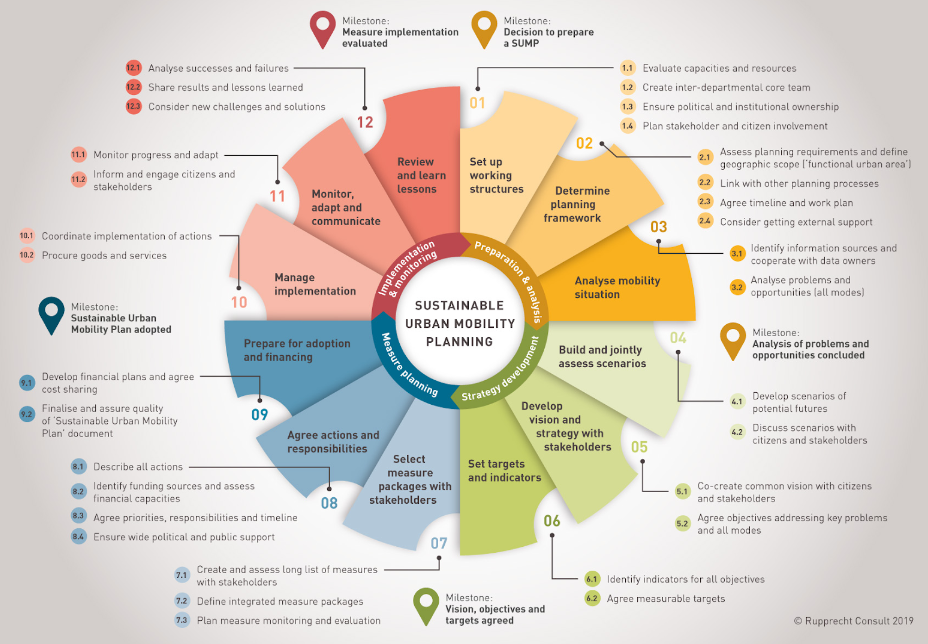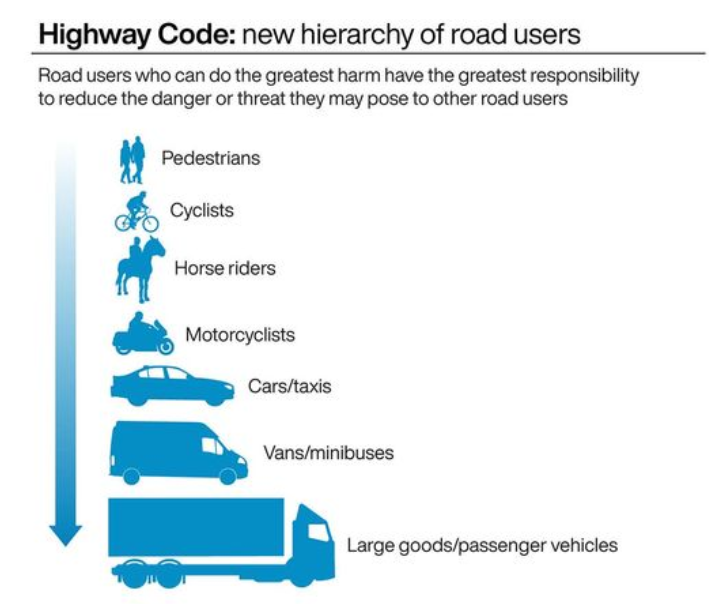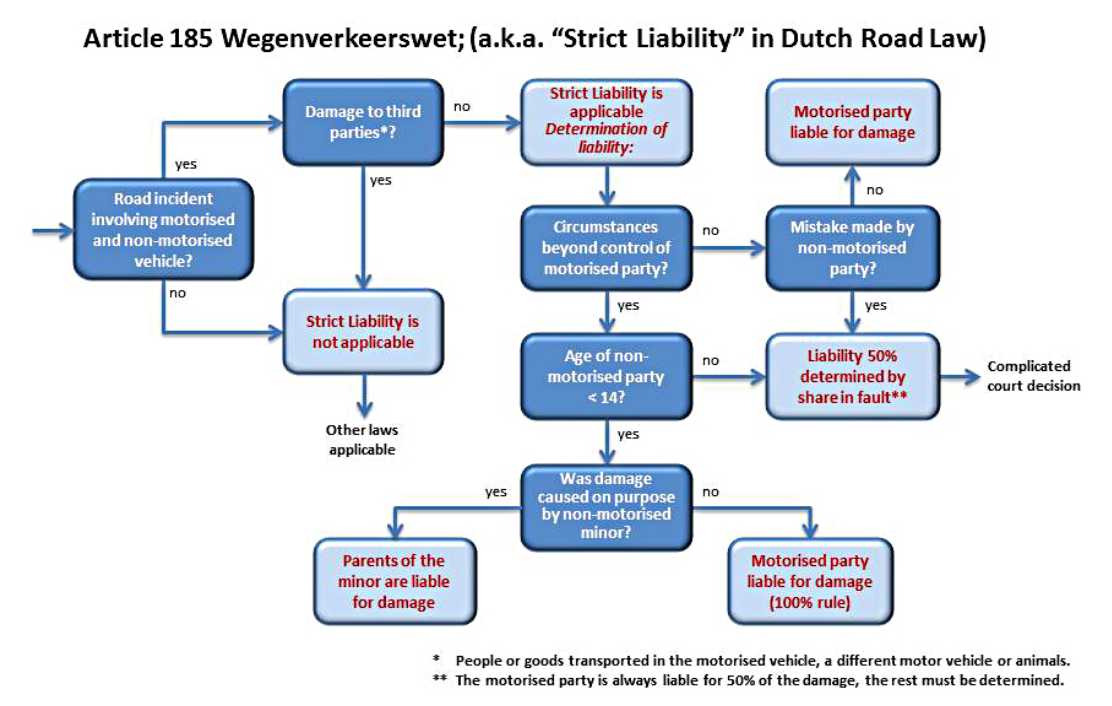Consultation on the Sustainable Urban Mobility Plan (SUMP) for the Valletta Region
In collaboration, three local NGOs – Friends of the Earth Malta, Moviment Graffitti and Rota – have prepared the following response to the SUMP consultation document.
1.0 General feedback
While welcoming the publishing of the draft of the long-awaited SUMP for the Valletta Region, the presented document is very brief and falls short of our expectations. There is a lack of well-defined and ambitious targets, one of the building blocks of a SUMP. Without targets, ambition is not operationalised, and indicators and progress cannot be measured.
1.1 Process
The SUMP Process (see the SUMP guidelines published by Eltis and Figure 1, an image representing the SUMP process below) is firmly built on on-going consultation with stakeholders. In the case of this SUMP, this is the first moment (apart from a first stakeholder meeting in 2017!) where NGOs, civil society and the general public are involved in this process. The SUMP process states that public participation should be included in the development of scenarios, in the development of the vision and strategy, in the selection of measure packages, among others. This has clearly not been the case in this process.
We do not agree with the way this consultation is being carried out – feedback should be provided to the overall document, and not in such a way as to not allow detailed feedback on the document. As already expressed, we feel the SUMP in its current form is disappointing, especially given the 5 year wait for its release for consultation. We feel we deserved a better document, with more details and clear, tangible, measurable and identifiable targets. Instead we have many aims that are mostly ‘exploratory’ at best, which means that this exercise fails to truly understand the urgency and scale of Malta’s traffic and transport problems.

Figure 1: image representing the SUMP process
1.2 Policy
In the section on ‘challenges’, the document states that one of the main challenges is that ‘No national policy measures to disincentivise private care [sic] usage are in force’. However, disappointingly, the proposed SUMP fails to incorporate any measures that restrict or reduce private car use (such as implementation of congestion charging, Low Emission Zones, removal of car lanes or access, paid and/or managed parking). Real modal shift only occurs when there is a combination of ‘carrots’ and ‘sticks’. Restricting private car use is needed alongside incentives to promote alternative modes of transport. This is a disappointing draft plan. It continues to incentivise private car use, and it refers to enforcement without any specifics or time lines. In the meantime, private car use will increase unabated.
The SUMP document states that “The measures being proposed in the SUMP complement the National Transport Strategy (NTS) and the accompanying Transport Master Plan (TMP)”. How will the SUMP measures ensure that targets in the Transport Master Plan for 2025 (thus, in the coming 3 years) are reached: for example the target of 47% modal share of car drivers by 2025, and the target of 50% zero emission urban logistics by 2025.
The Transport Master Plan also included the commitment to create a National Cycling Policy, which has still not been published in final form. The Low Carbon Development Strategy published in 2021 lists ‘active transport’ (i.e. walking, cycling) as one of the high-priority policy initiatives to reduce carbon emissions in the short-term (2020-2030). Now the SUMP mentions investment in infrastructure that encourages active modes of transport (1.1). This process needs to be guided by the promised National Cycling Policy, especially in relation to the creation of standards and guidelines for such infrastructure, to ensure the investment goes towards a high quality network that is safe, direct, connected, comfortable and attractive.
1.3 Goals & Objectives
Often, there are goals and objectives listed to “explore” or “evaluate” or “study” (e.g. 1.8, 1.9, 1.10, 1.13). These should not be listed as goals and objectives, but should be taken for granted as ongoing. Goals and objectives should outline concrete, explained and detailed ideas, with targets and set dates. In this respect, the SUMP fails to give any assurance that there will be concrete targets to reach, and there is no way to monitor the progress of its implementation.
The ‘Valletta Region’ comprises the main conurbation around Valletta. However, how does this Region relate to the new regions? The Harbour Regions are now part of other regions, e.g. the Central Region and Southern Region. How do actions in the Valletta Region relate to the national level and to actions being proposed or taken in the other Regions? There needs to be coordination between these different entities and levels of government to ensure the SUMP can be implemented effectively and contributes to national targets.
1.4 Cycling & Micro-Mobility
Commuting to the capital city and in the ‘Valletta Region’ on foot or by bicycle leaves a lot to be desired. The main routes through Marsa, Hamrun, Pieta have no direct, connected, safe routes. Many intersections do not have a safe place to cross for vulnerable road users, there are areas with too narrow or lacking pavements, places that are difficult or impossible to pass by bicycle, and areas that are perceived as unsafe due to insufficient lighting, poor road quality and exposure to fast-moving motorised vehicles. There are a number of potential measures completely missing from the proposed SUMP, e.g.: To promote safety for vulnerable road users, the SUMP should discuss and introduce the following concepts:
- Legal changes to presumed liability, legislation that determines who is at fault when an accident occurs, finding the more powerful road user liable by default, as they should carry greater responsibility. Currently, this is not clear and usually leaves the more vulnerable road user to search for compensation for damages. The UK recently introduced a new hierarchy of road users where the onus is on the larger vehicle to prove who was responsible in an accident as it has greater responsibility on the road (see Figure 2 below). The Netherlands has implemented presumed liability through their ‘Strict Liability’ law (see Figure 3 below) and has some of the lowest road accidents per kilometre cycled, showing the effect of such a law on improving overall road safety.
- Malta should update its Highway Code, as it has remained unchanged since 1999. The highway codes of many countries have been updated in the last decade to reflect changes in mobility patterns and modes. Malta’s highway code is based on the UK’s, the UK has updated it in 2021. The highway code can be used to signal needed change in the behaviour of motorised traffic toward non motorised traffic.
- To promote cycling, there is a need for secure and sheltered bicycle parking in major public transport hubs. To create short and safe routes, contraflows should be introduced in Malta.
- Financial incentives should be introduced to encourage cycling to work, taking inspiration from ‘cycle to work’ schemes that exist in other countries.
In the SUMP document there is no reference at all to e-kick scooters and other micromobility modes, which have grown rapidly in their uptake and use over the past few years, and should be included in the SUMP, to see how their use can be promoted and regulated.

Figure 2: new hierarchy of road users in UK highway code

Figure 3: Strict Liability law in the Netherlands
2.0 Point-by-point feedback
2.1 Incentivise alternatives to car use
2.1.1 Invest in infrastructure that encourages active modes of transport
What kind of crossings? Need to prioritise pedestrians/cyclists over car traffic. No detail on the type of “”mobility points”” Need to see a strategic policy (i.e. the National Cycling Policy and standards/ guidelines, to ensure the developed and implemented network is safe, connected and consistent.
2.1.2 Develop and map active mobility routes
While this is a good idea, we are disappointed that after 5 years this exercise is only being “”alluded to”” and not put out in detail for genuine feedback. There are local users and activists (e.g. from Rota) and researchers (e.g. the Institute for Climate Change and Sustainable Development, University of Malta) who already have invested a lot of work in mapping current best routes and proposing improvements to the infrastructure for walking and cycling. Take on board the experience of users and experts, e.g. looking at the maps on http://www.rota.mt and http://www.um.edu.mt/iccsd/ourprojects/walkingandcyclingaroundumcampus
2.1.3 Encourage walking and improve pedestrian infrastructure
An audit should be done of all walking and cycling infrastructure (pavements, cycling paths/lanes, crossings) to identify where improvements are needed to ensure adequate widths, safe crossings and green infrastructure to provide shade and mitigate noise and air pollution.
Consider this example from Amsterdam for mapping pavement widths and other attributes: https://maps.amsterdam.nl/sidewalks/?LANG=en.
2.1.4 Encourage walking and improve pedestrian infrastructure
Full pedestrianisation should also be piloted, especially in village cores / streets / urban conservation areas (UCA).
2.1.5 Trial timed-pedestrianisation in the direct vicinity of schools
How will this be enforced? Create fully pedestrianised areas around schools to encourage students to walk or cycle to school. Create walking/cycling corridors that are safe for children to cycle to school.
2.1.6 Incentivise cycling in the Region
There is no mention of establishing safe, segregated bike lanes. This is a major flaw, as the biggest deterrent to cycling uptake in Malta is perceived lack of safety. Bike lanes should be set up, segregated from cars, to facilitate transport through an interconnected network. If necessary, on wider rides with several lanes a car lane needs to be replaced by a bike lane, segregated.
2.1.7 Encourage green travel plans and green commuting plans in the Region
This should include funding for facilities such as showers and changing rooms for staff who choose to walk/cycle to work, who might require such facilities after their commute. Make Green Travel Plans mandatory for businesses/entities over a certain size, including follow-up on their implementation.
2.1.8 Explore sustainable mobility hubs of the future
The time is long past to “explore”. We need realistic, demonstrated outlines, and clear aims and targets with deadlines.
2.1.9 Explore and map combined transport routes
The time is long past to “”explore””. We need realistic, demonstrated outlines, and clear aims and targets with deadlines.
Additionally, one can already take a bike on all public ferries in Malta, so the suggestion is already implemented.
2.1.10 Explore and map combined transport routes
We already have “explored” this option with GoTo, for example. It failed. There is nothing to “explore”, but we have every opportunity to learn from why it worked or didn’t work.
2.1.11 Facilitate ferry usage for more localities
This should include an increase in ferry landing sites and routes, as well as extension of the service hours in the winter period, when currently ferry services stop at 19:00 in the evening.
While alternative transport solutions are commendable, the landing places for the ferries must not displace existing swimming spots as was proposed in Balluta by the Zammit Tabona ferry. And please consider the fact that swimmers and the public are not to be restricted to the pens (as in the swimming zones delineated by Transport Malta) but must be allowed to utilise and enjoy whole bays. Whilst it will be argued that ferry operations will be subject to strict conditions, this is doubtful. Once a ferry is up and running, any breaches will be not be enforced (in the same way development breaches on land have been routinely ignored).
Also, a realistic and third-party-reviewed assessment of the environmental credentials of the vessels to be used is required in order to avoid issues such as the one brought up in this report
€16 million EU-funded Bugibba ferry project threatens EU Natura 2000 site
Here, A €16 million project entirely funded by the EU for a new ferry landing, breakwater and ancillary facilities in Bugibba awarded to Polidano Group is threatening a Natura 2000 marine site off the coast of Bugibba, which the EU itself has designated for protection. This could also arise in the case of other places where there are Posidonia meadows. It is hoped that EU funds will not be used to the detriment of the marine environment.”
2.1.12 Facilitate public transport schedules
This is desperately needed. We also need more buses, and more reliable services. We should also explore the options of vehicles smaller than buses, such as vans. On the main corridors (e.g. south to Valletta, west to Valletta, north to Valletta, including stops at important destinations en route such as University/Mater Dei) there should be dedicated bus lanes to facilitate efficient and reliable public transport. There should be a pilot of a Bus Rapid Transit route to research the effectiveness in Malta. Malta Public Transport have a proposed BRT pilot project ready to be tested.
2.2 Transition to cleaner transportation
2.2.1 Incentivise increased roll-out of EV charging infrastructure in the Region
There has been little to no discussion on how to power these vehicles if uptake increases as desired. Malta’s electricity today is generated from fossil gas (through Delimara power plant) or other fossil fuels (through interconnector). If the shift to electrification is supposed to reduce carbon emissions, this shift needs to be accompanied by serious investment in renewable energy sources. Additionally, EV uptake still doesn’t solve the problem of traffic; there is a need to shift to cleaner and more efficient modes of transport.
2.2.2 Evaluate the potential roll-out of alternative fuels such as Hydrogen
The vast majority of hydrogen today (95-99% is produced from fossil fuels) and therefore not an improvement to current fuels. There is the potential to explore the use of ammonia instead of hydrogen, as it is easier to store and use. If one is using transported hydrogen, there might still be added carbon costs to that transport which defeats the purpose if the purpose is to lower CO2 emissions. When talking about green hydrogen (produced using renewable energy), it is more efficient to use renewable electricity directly, rather than hydrogen. Hydrogen may be a solution for harder to electricify vehicles, such as large vessels or vehicles.
2.2.3 Explore low emission zones in the Region
There needs to be a pilot of a low emission zone, not an ‘exploration’.
2.2.4 Explore low emission zones in the Region
Same as point 2.1, the source of this electricity should be discussed. There should be conditions that this should be from renewable sources, otherwise it is just shifting emissions from tailpipe to the power plant.
2.3 Optimising (the current) transport ecosystem
2.3.1 Undertake further data collection to inform measures
This should not be a goal or objective, but something done in the course of applying a goal or objective. We would like to see the measures, not plans on how to collect data to implement the measures. There is a serious lack of data, not only in relation to parking, particularly in the field of active transport (walking, cycling). There should be a strategy to collect data and publish data to the general public on pedestrian, cycling and car flows in as many locations as possible. This would enable setting measurable goals for all the points raised in this SUMP and create transparency over the implementation and effectiveness of measures. This SUMP should include the creation of a parking management plan for the Valletta Region.
2.3.2 Explore multi-purpose communal parking areas
While understandable as an objective, this scheme facilitates and encourages car use, because it allows for easier parking. We need to disincentivise car use. Should such areas be arranged, they should be made for bikes, scooters, etc with suitable monitoring and safety measures. There should be discussion whether there are other needs that can be met by using such public areas, e.g. for sports, leisure, socialising. There is also a danger in using “public land” – which type? There need to be strict provisions that this would not spill over to include farmland, for example.
2.3.3 Optimise Park & Ride facilities
While understandable as an objective, more Park & Ride facilities will not go far enough to disincentivise private vehicle use. We need better alternatives in the form of public transport. Better investment could be made in providing shuttle services to and from village/town/city hubs, rather than encouraging parking areas.
2.3.4 Increase enforcement in the Region
Much needed, but will not happen without suitable training and expansion of staff monitoring the situation.
2.3.5 Revisit timings for on-road public services
Why not expand this to also include trucks and large construction vehicles, which are very frequent and contribute greatly to traffic?
2.4 Optimise provision of Goods and Joint Services
2.4.1 Extend last mile delivery with shared vehicle
This should be extended to include the construction industry, if possible, which contributes greatly to traffic. This should be extended to the main industrial areas and business districts, notably areas within the Valletta Region such as Mriehel and Marsa.
2.4.2 Expand last mile delivery network
Last mile delivery should include e-cargo bikes, which are smaller, cleaner and quieter solutions for small streets in villages and towns.
2.4.3 Enforce proper use of un/loading bays
This should include the mapping of all un/loading bays and identification of further sites for un/loading.
2.4.4 Explore centralised logistics hubs
Ensure that local businesses and delivery services are included in this study, to tailor it to their needs and ensure uptake.
3.0 Further references and research
Our organisations, and members of our organisations, have written and contributed to a number of studies and articles to promote active and public transport. For further reference and insights from research on mobility topics in Malta, please refer to:
- Rota, Resources, Guidelines and Reports & Studies: https://www.rota.mt/our-wSusork/resources/
- Maas, S., 2021. Bicycle sharing systems and their role in the promotion of cycling as a mode of transport in southern European island cities, PhD Thesis, University of Malta. https://www.um.edu.mt/library/oar/handle/123456789/84934
- Debono, J., 2022. Tram or metro? No, the dedicated bus-lane… https://www.maltatoday.com.mt/news/national/115964/tram_or_metro_no_the_dedicated_buslane#.Y43zvr3MLIU
- Maas, S., 2022. People walking, cycling and taking public transport can come first. https://www.maltatoday.com.mt/environment/environment/118200/people_walking_cycling_public_transport_first_suzanne_maas#.Y43zwb3MLIU
4.0 Feedback on Questions
Which are the core specifics/issues of the Valletta Region that a Sustainable Urban Mobility Plan should cater for?
- The need to disincentivise car use.
- Creation of Safe, Direct, Cohesive, Comfortable and Attractive cycling networks, guided by national cycling infrastructure standards
- Dedicated space for public transport to operate effectively
- Legal changes to improve road safety, especially for vulnerable road users
- The ferry system currently in place should be nationalised, and/or guaranteed to work regardless of winter/summer schedules and tourist demand
Which areas (pillars) do you believe will be the greatest lever/s for the move to more sustainable mobility in the Valletta Region?
- Pillar 1: Incentivise alternatives to car use. However, we feel that all components are necessary and should be given due importance as part of a holistic whole.
- None of these pillars will gain any leverage without specific targets, objectives, monitoring (e.g. 50 km of cycling lanes by 2025, etc).
Which measures do you believe will have the greatest impact? Which measures should be lower priority than others?
- To summarise, anything which does not disincentivise car use should be a lower priority. This INCLUDES electric vehicles, which do not solve the problem of traffic on our roads. What we need are active and public modes of transport which are accessible, safe, reliable and desirable.
- Alternate measures that have not been mentioned in this document, for example, regular ferry trips across the harbours during night time irrespective of season, should be given due importance.

